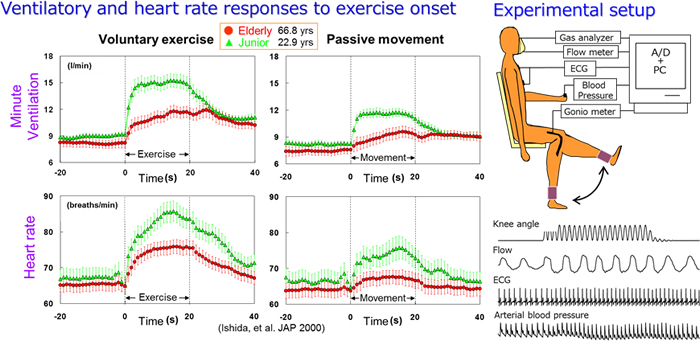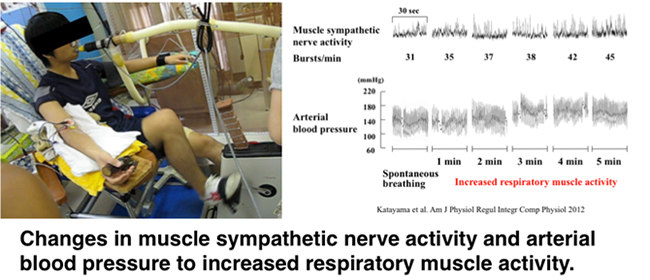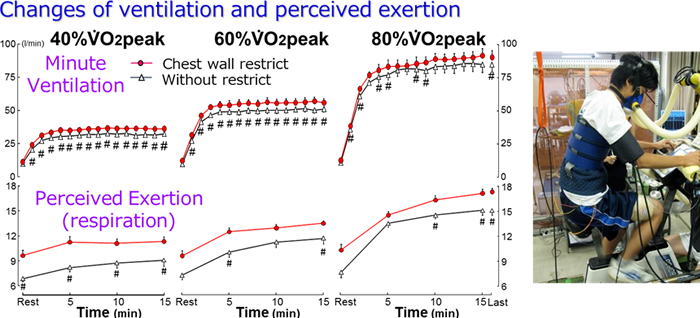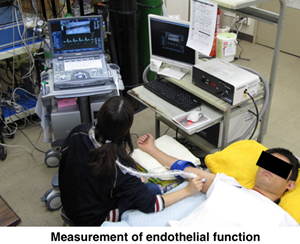Laboratories
- Back
- Top > Laboratories > Health Promotion Medicine(Cooperating field) > Exercise and Sports Physiology
Health Promotion Medicine(Cooperating field)Exercise and Sports Physiology
Introduction
Our laboratory is engaged in research concerning human respiratory and cardiovascular responses to exercise and adaptations to exercise, including training. Specifically, by observing respiratory and cardiovascular responses during dynamic exercise such as ventilation, oxygen uptake, heart rate, blood pressure, muscle sympathetic nervous activity (microneurography technique), blood flow to active or inactive muscles and to brain (ultrasound diagnostic equipment), we are elucidating respiratory and cardiovascular functions during exercise, their interactions, and the effects of training on these physiological functions. We hope to apply our findings to the treatment of life-style related disease, the prediction of acute mountain sickness, and develop techniques for respiratory muscle training.
Details are found on the following individual WEB site.
Research Projects
1. Respiratory and Cardiovascular Responses During Exercise
i) Clarification of characteristics and mechanisms of ventilatory increase at the onset of dynamic exercise
Ventilation increases immediately at the onset of dynamic exercise, a phenomenon called "exercise hyperpnea". The mechanisms of this have been a matter of debate in physiology for more than a century. Our laboratory is interested in the initial phase (within 20 s) at the onset of exercise. Our studies have revealed several characteristics of this response in various categories of subjects and in a variety of exercise situations. For example, we found that ventilatory response at the initial phase of exercise in the elderly is slower than that in the young. We have proposed a new hypothesis of exercise hyperpnea that we term "Volitional Control though Learning and Cognition" and we plan to proceed with experiments to test this hypothesis.

ii) Respiratory muscle activation and cardiovascular response during exercise
High-intensity whole body exercise elicits respiratory muscle fatigue. Recent studies reported that respiratory muscle fatigue causes an increase in muscle sympathetic nerve activity with a corresponding increase in arterial blood pressure. This sympathoexcitation occurs through a respiratory muscle fatigue-induced metaboreflex. It is likely that blood flow and oxygen transport to the working limb are reduced, thereby exacerbating limb fatigue and compromising exercise performance. Clinically, respiratory muscle work could play a particularly importance because a large respiratory muscle work appears during exercise in patient with chronic obstructive pulmonary disease and chronic obstructive pulmonary disease. We suppose that vasoconstriction, which is elicited by sympathoexcitation via large respiratory muscle activity during exercise, affects oxygen transport, limb muscle fatigue and, hence, exercise tolerance in patients.

2. Respiratory and Cardiovascular Responses to Exercise Under Various Environmental Conditions and Their Adaptations
i) Dynamics of respiratory and cardiovascular responses to exercise under hypoxia and chest wall restriction
Our laboratory is engaged in studying the respiratory and cardiovascular responses to various experimental conditions during exercise. Recently, we have developed a new and more convenient method to gradually decrease in O2 content similar to mountain climbing and are thus able to clarify the human physiological response to hypoxia during exercise. Applying this method, we are now trying to develop a screening test at sea level for predicting acute mountain sickness. Additionally, we observed ventilatory, heart rate, oxygen uptake, SpO2 responses during exercise with chest wall restriction as compared with normal conditions.

ii) Aerobic exercise in hypoxia and lifestyle-related diseases
Aerobic training at moderate altitude and under hypoxic conditions has been utilized by endurance athletes to improve aerobic exercise performance. Recent studies report that aerobic training in hypoxia is a more effective method to enhance the endothelial function than is training in normoxia. Additionally, we found that carbohydrate utilization is increased during exercise in moderate hypoxia as compared with normoxia. From the this result, we hypothesize that short-term living at moderate altitude with appropriate exercise may be developed as a natural remedy for the prevention of lifestyle-related diseases, e.g., cardiovascular diseases and type 2 diabetes mellitus.

Faculty Members
| Faculty | Position | Department |
|---|---|---|
| Koji Ishida | Professor | Exercise and Sports Physiology (Research Center of Health, Physical Fitness and Sports) |
| Keisho Katayama | Professor | Exercise and Sports Physiology (Research Center of Health, Physical Fitness and Sports) |
Bibliography
- 2016
- Itoh Y, Katayama K, Iwamoto E, Goto K, Suzuki Y, Ohya T, Takao K, Ishida K. Blunted blood pressure response during hyperpnoea in endurance runners. Respir Physiol Neurobiol, 2016; 230: 22-28.
- Katayama K, Ishida K, Saito M, Koike T, Ogoh S. Hypoxia attenuates cardiopulmonary reflex control of sympathetic nerve activity during mild dynamic leg exercise. Exp Physiol, 2016; 101: 377-386.
- Sato K, Iemitsu M, Katayama K, Ishida K, Kanao Y, Saito M. Responses of sex steroid hormones to different intensities of exercise in endurance athletes. Exp Physiol, 2016; 101: 168-175.
- Katayama K, Yamashita S, Iwamoto E, Ishida K. Flow-mediated dilation in the inactive limb following acute hypoxic exercise. Clin Physiol Funct Imaging, 2016; 36: 60-69.
- 2015
- Katayama K, Itoh Y, Saito M, Koike T, Ishida K. Sympathetic vasomotor outflow and blood pressure increase during exercise with expiratory resistance. Physiol Rep, 2015; 3: e12421.
- Iwamoto E, Katayama K, Ishida K. Exercise intensity modulates brachial artery retrograde blood flow and shear rate during leg cycling in hypoxia. Physiol Rep, 2015; 3.
- Katayama K, Suzuki Y, Hoshikawa M, Ohya T, Oriishi M, Itoh Y, Ishida K. Hypoxia exaggerates inspiratory accessory muscle deoxygenation during hyperpnoea. Respir Physiol Neurobiol, 2015; 211: 1-8.
- 2014
- Petousi N, Croft QP, Cavalleri GL, Cheng HY, Formenti F, Ishida K, Lunn D, McCormack M, Shianna KV, Talbot NP, Ratcliffe PJ, Robbins PA. Tibetans living at sea level have a hyporesponsive hypoxia-inducible factor system and blunted physiological responses to hypoxia. J Appl Physiol (1985), 2014; 116: 893-904.
- Katayama K, Ishida K, Saito M, Koike T, Hirasawa A, Ogoh S. Enhanced muscle pump during mild dynamic leg exercise inhibits sympathetic vasomotor outflow. Physiol Rep, 2014; 2: e12070.
- 2013
- Iwamoto E, Katayama K, Yamashita S, Oshida Y, Ishida K. Retrograde blood flow in the inactive limb is enhanced during constant-load leg cycling in hypoxia. Eur J Appl Physiol, 2013; 113: 2565-2575.
- Katayama K, Yamashita S, Ishida K, Iwamoto E, Koike T, Saito M. Hypoxic effects on sympathetic vasomotor outflow and blood pressure during exercise with inspiratory resistance. Am J Physiol Regul Integr Comp Physiol, 2013; 304: R374-382.
- Katayama K, Fujita O, Iemitsu M, Kawano H, Iwamoto E, Saito M, Ishida K. The effect of acute exercise in hypoxia on flow-mediated vasodilation. Eur J Appl Physiol, 2013; 113: 349-357.
- 2012
- Iwamoto E, Katayama K, Oshida Y, Ishida K. Hypoxia augments oscillatory blood flow in brachial artery during leg cycling. Med Sci Sports Exerc, 2012; 44: 1035-1042.
- Ishida K, Miyamura M. Neural regulation of respiration during exercise -Beyond the conventional central command and afferent feedback mechanisms. The Journal of Physical Fitness and Sports Medicine, 2012; 1: 235-245.
- Katayama K, Iwamoto E, Ishida K, Koike T, Saito M. Inspiratory muscle fatigue increases sympathetic vasomotor outflow and blood pressure during submaximal exercise. Am J Physiol Regul Integr Comp Physiol, 2012; 302: R1167-1175.
- 2011
- Katayama K, Ishida K, Iwamoto E, Iemitsu M, Koike T, Saito M. Hypoxia augments muscle sympathetic neural response to leg cycling. Am J Physiol Regul Integr Comp Physiol, 2011; 301: R456-464.
- Hotta N, Ishida K, Sato K, Koike T, Katayama K, Akima H. The effect of intense interval cycle-training on unloading-induced dysfunction and atrophy in the human calf muscle. J Physiol Anthropol, 2011; 30: 29-35.
- 2010
- Ishida K, Katayama K, Akima H, Iwase S, Sato K, Hotta N, Miyamura M. Effects of deconditioning on the initial ventilatory and circulatory responses at the onset of exercise in man. Adv Exp Med Biol, 2010; 669: 319-322.
- Katayama K, Goto K, Ishida K, Ogita F. Substrate utilization during exercise and recovery at moderate altitude. Metabolism, 2010; 59: 959-966.
- Katayama K, Yoshitake Y, Watanabe K, Akima H, Ishida K. Muscle deoxygenation during sustained and intermittent isometric exercise in hypoxia. Med Sci Sports Exerc, 2010; 42: 1269-1278.
- Sato K, Katayama K, Hotta N, Ishida K, Akima H. Aerobic exercise capacity and muscle volume after lower limb suspension with exercise countermeasure. Aviat Space Environ Med, 2010; 81: 1085-1091.
Research Keywords
exercise、 human、 respiration、 circulation、 training、 hypoxia、 respiratory muscles、 exercise hyperpneahyperpnoeanea
Others
We are advertising some graduate students who are interested in exercise/training and respiratory and cardiovascular system. Many graduate students have been belonging to our laboratory whose backgrounds are sports science, dietetics, physiotherapy and medicine. Most of them have obtained Ph.D degree and some of them have succeeded as university faculty members. Exercise is tightly linked with human health and medicine. It is certain that what you have learned here should be useful for your educational or medical practice. Let's visit our laboratory!